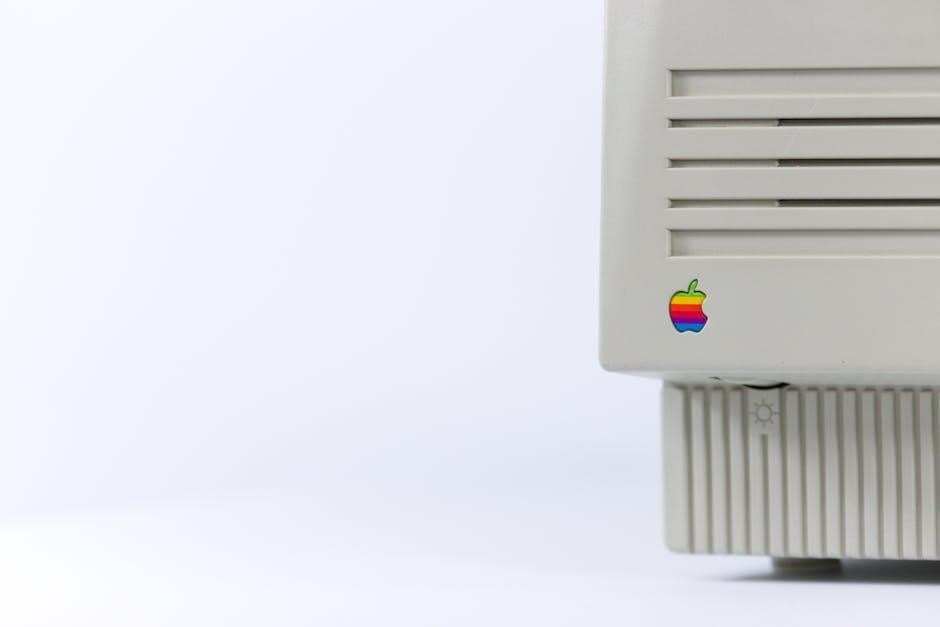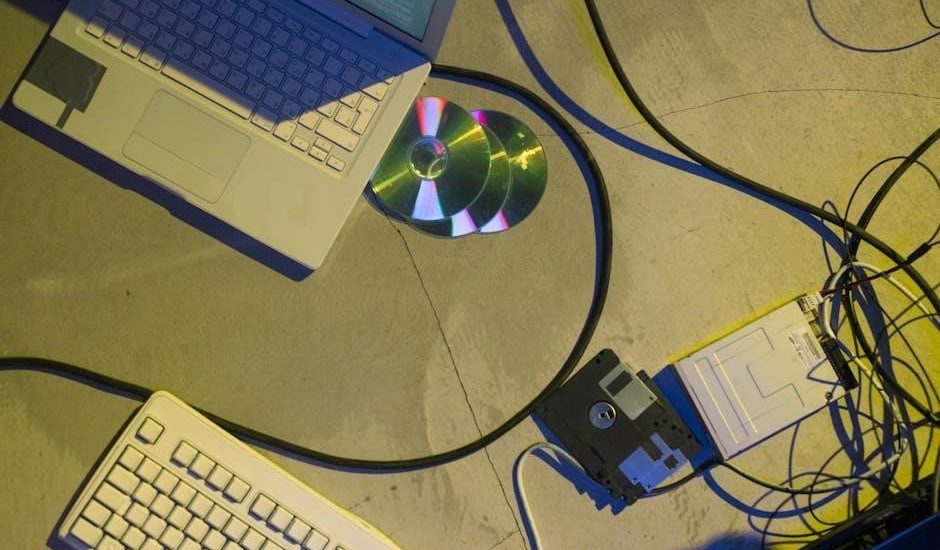The history of computers traces the journey from ancient mechanical devices to modern digital marvels‚ highlighting key milestones‚ innovators‚ and the evolution of technology that shaped society.

1.1 Overview of the Evolution of Computing Technology
The evolution of computing technology spans thousands of years‚ from ancient counting tools like the abacus to modern digital computers. Early mechanical devices‚ such as Pascal’s Pascaline and Babbage’s analytical engine‚ laid the groundwork for programmable machines. The 20th century saw the rise of electronic computers‚ starting with ENIAC‚ the first general-purpose electronic computer. This was followed by advancements in transistors‚ integrated circuits‚ and microprocessors‚ leading to smaller‚ faster‚ and more affordable computers. The development of personal computers‚ the internet‚ and mobile devices marked the digital revolution‚ transforming society and enabling global connectivity.

1.2 Importance of Studying Computer History
Studying the history of computers provides insights into the foundational concepts and innovations that shaped modern technology. It highlights the contributions of pioneers like Charles Babbage and the development of early machines such as ENIAC‚ which laid the groundwork for digital computing. Understanding this evolution helps appreciate how technological advancements have transformed society‚ from personal computing to the internet. It also fosters a deeper appreciation for the challenges overcome and the visionary ideas that continue to influence contemporary advancements in computing and artificial intelligence.

Pre-Mechanical Computing
The abacus‚ an ancient counting tool‚ marked the beginning of pre-mechanical computing‚ enabling basic arithmetic and paving the way for manual calculation methods.
2.1 The Abacus and Early Counting Devices
The abacus‚ invented around 3500 BC‚ was the first counting device‚ enabling basic arithmetic operations like addition and subtraction. Its simple design used beads on wires to represent numbers‚ revolutionizing early trade and record-keeping. Early counting devices like tally sticks and stone tokens also emerged‚ laying the groundwork for more complex mechanical calculators. These tools were crucial in ancient civilizations‚ such as Mesopotamia‚ Egypt‚ and China‚ demonstrating humanity’s early quest for efficient computation. They represent the foundational steps in the evolution of computing technology.
2.2 Mechanical Computing Machines: From Pascal to Babbage
The development of mechanical computing machines began with Blaise Pascal’s Pascaline in 1642‚ a mechanical calculator for basic arithmetic. Gottfried Wilhelm Leibniz later improved it by adding multiplication and division. In the 19th century‚ Charles Babbage conceptualized theDifference Engine and the Analytical Engine‚ introducing programmability and storage concepts. Although never built‚ Babbage’s designs laid the groundwork for modern computers. These innovations marked the transition from manual calculation to mechanical computation‚ showcasing human ingenuity in automating mathematical processes and paving the way for future technological advancements in computing.
Electronic Computers
Electronic computers emerged with ENIAC and ABC‚ pioneering digital computation and redefining technology. These machines‚ developed during World War II‚ laid the foundation for modern computing.
3.1 The First Electronic Digital Computers: ENIAC and ABC
The first electronic digital computers‚ ENIAC and ABC‚ revolutionized computing in the mid-20th century. ENIAC‚ developed in 1946 by John Mauchly and J. Presper Eckert‚ was the first large-scale electronic computer‚ capable of solving complex mathematical problems. It used vacuum tubes and was designed to break German codes during World War II. ABC‚ invented by John Vincent Atanasoff and Clifford Berry in the 1930s‚ introduced the concept of binary computing and electronic storage. Both machines laid the groundwork for modern computers‚ with ENIAC gaining widespread recognition and ABC influencing later innovations in digital technology.
3.2 The Role of Charles Babbage in Computer History
Charles Babbage‚ often hailed as the “father of the computer‚” pioneered mechanical computing in the 19th century. His Difference Engine and Analytical Engine introduced groundbreaking concepts‚ including programmability and a central processing unit. Although his machines were never built during his lifetime‚ Babbage’s visionary ideas laid the foundation for modern computing. His work on the Analytical Engine‚ with Ada Lovelace’s contributions‚ marked the beginning of computer science. Babbage’s relentless pursuit of innovation and theoretical frameworks made him a cornerstone in the evolution of digital technology‚ inspiring future generations to realize his mechanical visions electronically.
Generations of Computers
Computers are classified into generations based on technological advancements. Each generation represents a significant leap in design‚ performance‚ and functionality‚ from vacuum tubes to artificial intelligence.
4.1 First Generation: Vacuum Tubes
The first generation of computers (1940s–1950s) relied on vacuum tubes‚ bulky electronic components that consumed significant power and generated intense heat. ENIAC (1946)‚ the first general-purpose electronic computer‚ exemplified this era‚ using over 17‚000 tubes. These machines were massive‚ unreliable‚ and prone to overheating but laid the groundwork for modern computing. Their primary function was to perform calculations faster than mechanical devices‚ aiding in code-breaking and scientific computations during World War II. Despite limitations‚ this generation marked the beginning of the digital revolution‚ paving the way for smaller‚ more efficient technologies in subsequent generations.
4.2 Second Generation: Transistors
The second generation of computers emerged in the late 1950s‚ replacing vacuum tubes with transistors‚ which were smaller‚ faster‚ and more reliable. This era introduced magnetic core memory‚ improving storage capabilities‚ and enabled the development of high-level programming languages like COBOL and FORTRAN. Computers like IBM 1401 became iconic‚ reducing size and power consumption while increasing efficiency. Transistors revolutionized computing‚ making it more accessible for businesses and universities‚ and marked a significant leap toward modern computing. This generation laid the foundation for commercial computing‚ paving the way for the integrated circuits of the next generation.
4.3 Third Generation: Integrated Circuits
The third generation of computers‚ emerging in the 1960s‚ introduced integrated circuits (ICs)‚ where multiple transistors were combined on a single silicon chip. This innovation greatly reduced size‚ increased speed‚ and improved reliability. Computers like the IBM System/360 became iconic‚ offering modular design and compatibility. Integrated circuits enabled the development of more sophisticated software and programming languages‚ such as PL/1. This era also saw advancements in magnetic storage and terminals‚ making computers more accessible to businesses and universities. The integration of circuits marked a pivotal shift toward modern computing‚ setting the stage for the microprocessor era.
4.4 Fourth Generation: Microprocessors
The fourth generation of computers‚ emerging in the 1970s‚ was defined by the introduction of microprocessors—single-chip CPUs integrating all central processing functions. The Intel 4004‚ released in 1971‚ was the first microprocessor‚ revolutionizing computing by enabling smaller‚ faster‚ and more affordable systems. This era saw the rise of personal computers‚ with iconic models like the Apple II and IBM PC. Microprocessors also spurred advancements in software‚ including graphical user interfaces and productivity applications. Their impact extended beyond personal computing‚ influencing embedded systems and industrial applications‚ and laid the foundation for the modern digital landscape.
4.5 Fifth Generation: Artificial Intelligence
The fifth generation of computers is characterized by the integration of artificial intelligence (AI)‚ marking a significant shift from traditional computing. This era focuses on developing machines that can learn‚ reason‚ and interact with humans naturally. Advances in machine learning‚ natural language processing‚ and neural networks have driven this evolution. Applications like voice recognition‚ robotics‚ and autonomous systems exemplify this generation’s capabilities. The fifth generation also emphasizes parallel processing and quantum computing‚ aiming to solve complex problems beyond the reach of earlier systems. This era represents a convergence of technology and intelligence‚ reshaping industries and everyday life profoundly.

Modern Computing and Beyond
Modern computing has revolutionized society through the internet‚ mobile devices‚ and personal computers‚ enabling global connectivity and transforming how information is accessed and shared worldwide.

5.1 The Development of Personal Computers
The development of personal computers revolutionized individual access to computing power‚ beginning in the 1970s with models like the Apple I and II. IBM’s 1981 PC‚ powered by MS-DOS‚ popularized business use. The 1984 Macintosh introduced graphical user interfaces (GUIs)‚ making computers more user-friendly. Microsoft’s Windows further democratized computing in the 1990s. Personal computers transformed industries‚ enabling home productivity‚ creativity‚ and connectivity. They laid the foundation for modern mobile devices and the digital age‚ reshaping how people live‚ work‚ and communicate globally.
5.2 The Rise of the Internet and Mobile Computing
The advent of the internet in the 1990s revolutionized computing‚ enabling global communication and information sharing. Mobile computing emerged with smartphones and tablets‚ integrating the internet into daily life. This shift transformed industries‚ fostering e-commerce‚ social media‚ and remote work. Advances in wireless technology and cloud computing further enhanced connectivity. The convergence of the internet and mobile devices created a hyper-connected world‚ reshaping how people interact‚ access information‚ and utilize computing resources on the go‚ driving innovation and societal change at an unprecedented pace.





